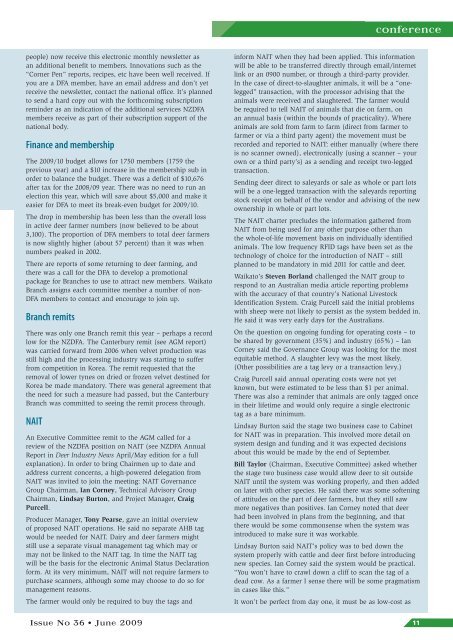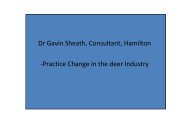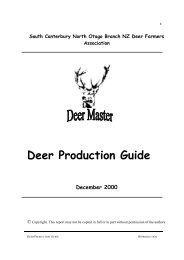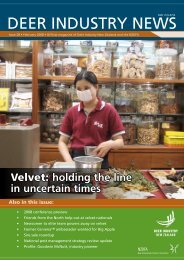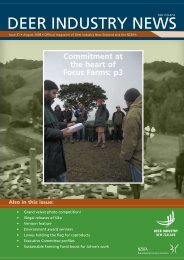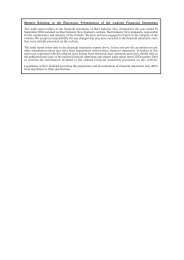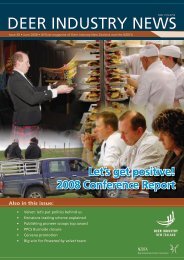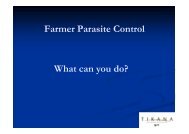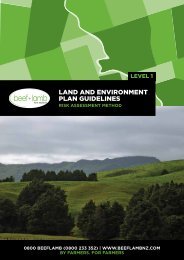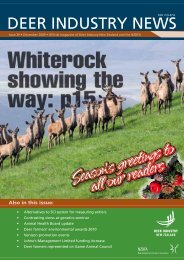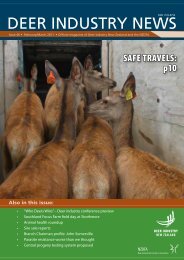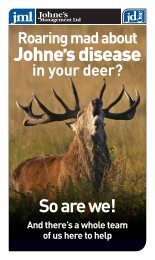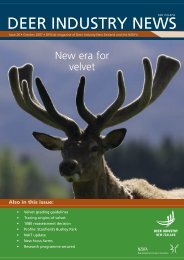Deer Industry News #36 June 2009 - Deer Industry New Zealand
Deer Industry News #36 June 2009 - Deer Industry New Zealand
Deer Industry News #36 June 2009 - Deer Industry New Zealand
- No tags were found...
Create successful ePaper yourself
Turn your PDF publications into a flip-book with our unique Google optimized e-Paper software.
conferencepeople) now receive this electronic monthly newsletter asan additional benefit to members. Innovations such as the“Corner Pen” reports, recipes, etc have been well received. Ifyou are a DFA member, have an email address and don’t yetreceive the newsletter, contact the national office. It’s plannedto send a hard copy out with the forthcoming subscriptionreminder as an indication of the additional services NZDFAmembers receive as part of their subscription support of thenational body.Finance and membershipThe <strong>2009</strong>/10 budget allows for 1750 members (1759 theprevious year) and a $10 increase in the membership sub inorder to balance the budget. There was a deficit of $10,676after tax for the 2008/09 year. There was no need to run anelection this year, which will save about $5,000 and make iteasier for DFA to meet its break-even budget for <strong>2009</strong>/10.The drop in membership has been less than the overall lossin active deer farmer numbers (now believed to be about3,100). The proportion of DFA members to total deer farmersis now slightly higher (about 57 percent) than it was whennumbers peaked in 2002.There are reports of some returning to deer farming, andthere was a call for the DFA to develop a promotionalpackage for Branches to use to attract new members. WaikatoBranch assigns each committee member a number of non-DFA members to contact and encourage to join up.Branch remitsThere was only one Branch remit this year – perhaps a recordlow for the NZDFA. The Canterbury remit (see AGM report)was carried forward from 2006 when velvet production wasstill high and the processing industry was starting to sufferfrom competition in Korea. The remit requested that theremoval of lower tynes on dried or frozen velvet destined forKorea be made mandatory. There was general agreement thatthe need for such a measure had passed, but the CanterburyBranch was committed to seeing the remit process through.NAITAn Executive Committee remit to the AGM called for areview of the NZDFA position on NAIT (see NZDFA AnnualReport in <strong>Deer</strong> <strong>Industry</strong> <strong><strong>New</strong>s</strong> April/May edition for a fullexplanation). In order to bring Chairmen up to date andaddress current concerns, a high-powered delegation fromNAIT was invited to join the meeting: NAIT GovernanceGroup Chairman, Ian Corney, Technical Advisory GroupChairman, Lindsay Burton, and Project Manager, CraigPurcell.Producer Manager, Tony Pearse, gave an initial overviewof proposed NAIT operations. He said no separate AHB tagwould be needed for NAIT. Dairy and deer farmers mightstill use a separate visual management tag which may ormay not be linked to the NAIT tag. In time the NAIT tagwill be the basis for the electronic Animal Status Declarationform. At its very minimum, NAIT will not require farmers topurchase scanners, although some may choose to do so formanagement reasons.The farmer would only be required to buy the tags andinform NAIT when they had been applied. This informationwill be able to be transferred directly through email/internetlink or an 0900 number, or through a third-party provider.In the case of direct-to-slaughter animals, it will be a “onelegged”transaction, with the processor advising that theanimals were received and slaughtered. The farmer wouldbe required to tell NAIT of animals that die on farm, onan annual basis (within the bounds of practicality). Whereanimals are sold from farm to farm (direct from farmer tofarmer or via a third party agent) the movement must berecorded and reported to NAIT: either manually (where thereis no scanner owned), electronically (using a scanner – yourown or a third party’s) as a sending and receipt two-leggedtransaction.Sending deer direct to saleyards or sale as whole or part lotswill be a one-legged transaction with the saleyards reportingstock receipt on behalf of the vendor and advising of the newownership in whole or part lots.The NAIT charter precludes the information gathered fromNAIT from being used for any other purpose other thanthe whole-of-life movement basis on individually identifiedanimals. The low frequency RFID tags have been set as thetechnology of choice for the introduction of NAIT – stillplanned to be mandatory in mid 2011 for cattle and deer.Waikato’s Steven Borland challenged the NAIT group torespond to an Australian media article reporting problemswith the accuracy of that country’s National LivestockIdentification System. Craig Purcell said the initial problemswith sheep were not likely to persist as the system bedded in.He said it was very early days for the Australians.On the question on ongoing funding for operating costs – tobe shared by government (35%) and industry (65%) – IanCorney said the Governance Group was looking for the mostequitable method. A slaughter levy was the most likely.(Other possibilities are a tag levy or a transaction levy.)Craig Purcell said annual operating costs were not yetknown, but were estimated to be less than $1 per animal.There was also a reminder that animals are only tagged oncein their lifetime and would only require a single electronictag as a bare minimum.Lindsay Burton said the stage two business case to Cabinetfor NAIT was in preparation. This involved more detail onsystem design and funding and it was expected decisionsabout this would be made by the end of September.Bill Taylor (Chairman, Executive Committee) asked whetherthe stage two business case would allow deer to sit outsideNAIT until the system was working properly, and then addedon later with other species. He said there was some softeningof attitudes on the part of deer farmers, but they still sawmore negatives than positives. Ian Corney noted that deerhad been involved in plans from the beginning, and thatthere would be some commonsense when the system wasintroduced to make sure it was workable.Lindsay Burton said NAIT’s policy was to bed down thesystem properly with cattle and deer first before introducingnew species. Ian Corney said the system would be practical.“You won’t have to crawl down a cliff to scan the tag of adead cow. As a farmer I sense there will be some pragmatismin cases like this.”It won’t be perfect from day one, it must be as low-cost asIssue No 36 • <strong>June</strong> <strong>2009</strong> 11


